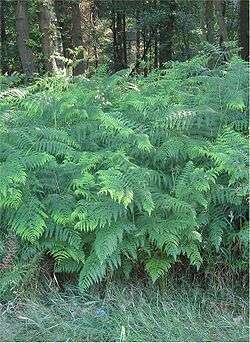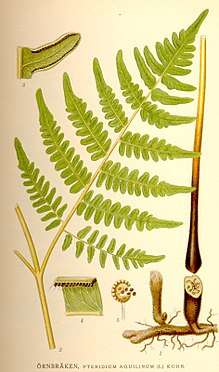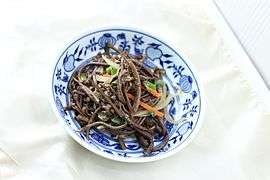Pteridium aquilinum
| Pteridium aquilinum | |
|---|---|
 | |
| Scientific classification | |
| Kingdom: | Plantae |
| Division: | Pteridophyta |
| Class: | Polypodiopsida/Pteridopsida (disputed) |
| Order: | Polypodiales |
| Family: | Dennstaedtiaceae |
| Genus: | Pteridium |
| Species: | P. aquilinum |
| Binomial name | |
| Pteridium aquilinum | |
Pteridium aquilinum (bracken, brake or common bracken), also known as eagle fern, and Eastern brakenfern,[1] is a species of fern occurring in temperate and subtropical regions in both hemispheres. The extreme lightness of its spores has led to its global distribution.
Etymology
Common bracken was first described as Pteris aquilina by Carl Linnaeus, in Volume 2 of his Species Plantarum in 1753. The origin of the specific epithet derived from the Latin aquila "eagle". In the reprint of the Flora Suecica in 1755, Linnaeus explains that the name refers to the image of an eagle seen in the transverse section of the root.[2] In spite of this, the opinion has been forwarded that the name pertains to the shape of the mature fronds appearing akin to an eagle's wing.[3] However, medieval scholars, including Erasmus, thought the pattern of the fibres seen in a transverse section of the stipe resembled a double-headed eagle or oak tree.
Taxonomy
It was traditionally treated as the sole species in the genus Pteridium (brackens); authorities have split and recognised up to 11 species in the genus, however. It was placed in the genus Pteridium by Friedrich Adalbert Maximilian Kuhn in 1879.[4]
Description
Common bracken is a herbaceous perennial plant, deciduous in winter. The large, roughly triangular fronds are produced singly, arising upwards from an underground rhizome, and grow to 1–3 m (3–10 ft) tall; the main stem, or stipe, is up to 1 cm (0.4 in) diameter at the base.
- Amphicribral vascular bundle of a common bracken rhizome

Distribution
An adaptable plant, bracken readily colonises disturbed areas. It can even be aggressive in countries where it is native, such as England, where it has invaded heather (Calluna vulgaris (L.) Hull) stands on the North Yorkshire moors.[5]
Culinary use
Bracken is a widely eaten vegetable in Korea, Japan and parts of China.[6]
Korea
In Korea, soaked, parboiled, and stir-fried bracken is often eaten as namul (seasoned vegetable side dish).[7] It is also a classic ingredient of bibimbap.[8]
 Dried gosari (Eastern brakenfern)
Dried gosari (Eastern brakenfern) Gosari-namul (seasoned stir-fried braken)
Gosari-namul (seasoned stir-fried braken)
Controversy over the dangers
The plant contains the carcinogenic compound ptaquiloside.[9] High stomach cancer rates are found in Japan and North Wales, where the young stems are used as a vegetable, but it is unknown whether bracken plays any part at all.[10] Consumption of ptaquiloside-contaminated milk is thought to contribute to human gastric cancer in the Andean states of Venezuela.[11] The spores have also been implicated as carcinogens.
However, ptaquiloside is water soluble, and is reduced by soaking bracken in cool water.[6] It also degenerates at room temperature, which explains why the rat studies were done with the toxin stored at −20 °C (−4 °F).[6] At boiling temperature, carcinogen denatures almost completely.[6] Salt and baking soda also help with volatilizing the chemical.[6] Further discussions on the nature of different fern species and their toxicity can be found under.[12]
It has been suggested that selenium supplementation can prevent as well as reverse the immunotoxic effects induced by ptaquiloside from Pteridium aquilinum.[13]
References
- ↑ Korea National Arboretum (2015). English Names for Korean Native Plants (PDF). Pocheon: National Arboretum. p. 594. ISBN 978-89-97450-98-5. Archived from the original (PDF) on 25 May 2017. Retrieved 6 December 2016 – via Korea Forest Service.
- ↑ radix oblique dissecta refert aliquatenus aquilam imperialem
- ↑ Austin, Daniel F. (2004). Florida ethnobotany. CRC Press. p. 551. ISBN 978-0-8493-2332-4. Retrieved 30 June 2010.
- ↑ Thomson, John A. (2004). "Towards a taxonomic revision of Pteridium (Dennstaedtiaceae)". Telopea. 10 (4): 793–803.
- ↑ Whitehead, S J; Digby, J (1997). "The morphology of bracken (Pteridium aquilinum (L.) Kuhn) in the North York Moors—a comparison of the mature stand and the interface with heather (Calluna vulgaris (L.) Hull) 1. The fronds". Annals of Applied Biology. 131: 103–116. doi:10.1111/j.1744-7348.1997.tb05399.x.
- 1 2 3 4 5 Shaw, Hank (30 June 2011). "The Bracken Fern: A Natural Born Killer?". The Atlantic. Retrieved 19 April 2017.
- ↑ Mishan, Ligaya (16 February 2017). "At Cafe Lily, the Korean-Uzbek Menu Evokes a Past Exodus". The New York Times. Retrieved 19 April 2017.
- ↑ Fontella, Amelia Cook (16 February 2017). "I brake for fernbrake". Isthmus. Retrieved 19 April 2017.
- ↑ Gomes, Joana; Magalhães, Ana; Michel, Valérie; Amado, Inês F; Aranha, Paulo; Ovesen, Rikke G; Hansen, Hans C. B; Gärtner, Fátima; Reis, Celso A; Touati, Eliette (2012). "Pteridium aquilinum and Its Ptaquiloside Toxin Induce DNA Damage Response in Gastric Epithelial Cells, a Link with Gastric Carcinogenesis". Toxicological Sciences. 126 (1): 60–71. doi:10.1093/toxsci/kfr329. PMID 22143989.
- ↑ I A Evans; B Widdop; R S Jones; G D Barber; H Leach; D L Jones & R Mainwaring-Burton (1971). "The possible human hazard of the naturally occurring bracken carcinogen". Biochem. J. 124 (2): 29P–30P. PMC 1177200. PMID 5158492.
- ↑ Alonso‐Amelot, Miguel E; Avendaño, Marisabel (2001). "Possible association between gastric cancer and bracken fern in Venezuela: An epidemiologic study". International Journal of Cancer. 91 (2): 252–259. doi:10.1002/1097-0215(200002)9999:9999<::AID-IJC1028>3.0.CO;2-H.
- ↑ Dion, C; Haug, C; Guan, H; Ripoll, C; Spiteller, P; Coussaert, A; Boulet, E; Schmidt, D; Wei, J; Zhou, Y; Lamottke, K (2015). "Evaluation of the anti-inflammatory and antioxidative potential of four fern species from China intended for use as food supplements". Natural Product Communications. 10 (4): 597–603. PMID 25973486.
- ↑ Latorre, A.O; Caniceiro, B.D; Wysocki, H.L; Haraguchi, M; Gardner, D.R; Górniak, S.L (2011). "Selenium reverses Pteridium aquilinum-induced immunotoxic effects". Food and Chemical Toxicology. 49 (2): 464–470. doi:10.1016/j.fct.2010.11.026.